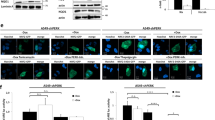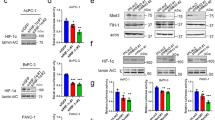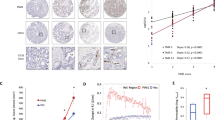Abstract
Previously, it has been shown that pancreatic ductal adenocarcinoma (PDA) tumors exhibit high levels of hypoxia, characterized by low oxygen pressure (pO2) and decreased O2 intracellular perfusion. Chronic hypoxia is strongly associated with resistance to cytotoxic chemotherapy and chemoradiation in an understudied phenomenon known as hypoxia-induced chemoresistance. The hypoxia-inducible, pro-oncogenic, serine–threonine kinase PIM1 (Proviral Integration site for Moloney murine leukemia virus 1) has emerged as a key regulator of hypoxia-induced chemoresistance in PDA and other cancers. Although its role in therapeutic resistance has been described previously, the molecular mechanism behind PIM1 overexpression in PDA is unknown. Here, we demonstrate that cis-acting AU-rich elements (ARE) present within a 38-base pair region of the PIM1 mRNA 3′-untranslated region mediate a regulatory interaction with the mRNA stability factor HuR (Hu antigen R) in the context of tumor hypoxia. Predominantly expressed in the nucleus in PDA cells, HuR translocates to the cytoplasm in response to hypoxic stress and stabilizes the PIM1 mRNA transcript, resulting in PIM1 protein overexpression. A reverse-phase protein array revealed that HuR-mediated regulation of PIM1 protects cells from hypoxic stress through phosphorylation and inactivation of the apoptotic effector BAD and activation of MEK1/2. Importantly, pharmacological inhibition of HuR by MS-444 inhibits HuR homodimerization and its cytoplasmic translocation, abrogates hypoxia-induced PIM1 overexpression and markedly enhances PDA cell sensitivity to oxaliplatin and 5-fluorouracil under physiologic low oxygen conditions. Taken together, these results support the notion that HuR has prosurvival properties in PDA cells by enabling them with growth advantages in stressful tumor microenvironment niches. Accordingly, these studies provide evidence that therapeutic disruption of HuR’s regulation of PIM1 may be a key strategy in breaking an elusive chemotherapeutic resistance mechanism acquired by PDA cells that reside in hypoxic PDA microenvironments.
This is a preview of subscription content, access via your institution
Access options
Subscribe to this journal
Receive 50 print issues and online access
$259.00 per year
only $5.18 per issue
Buy this article
- Purchase on Springer Link
- Instant access to full article PDF
Prices may be subject to local taxes which are calculated during checkout







Similar content being viewed by others
References
ACS Cancer Facts & Figures 2013. American Cancer Society: Atlanta, GA, USA, 2014. Available at http://www.cancer.org/acs/groups/content/@editorial/documents/document/acspc-044552.pdf.
Rahib L, Smith BD, Aizenberg R, Rosenzweig AB, Fleshman JM, Matrisian LM . Projecting cancer incidence and deaths to 2030: the unexpected burden of thyroid, liver, and pancreas cancers in the United States. Cancer Res 2014; 74: 2913–2921.
Conroy T, Desseigne F, Ychou M, Bouche O, Guimbaud R, Becouarn Y et al. FOLFIRINOX versus gemcitabine for metastatic pancreatic cancer. N Engl J Med 2011; 364: 1817–1825.
Von Hoff DD, Ervin T, Arena FP, Chiorean EG, Infante J, Moore M et al. Increased survival in pancreatic cancer with nab-paclitaxel plus gemcitabine. N Engl J Med 2013; 369: 1691–1703.
Jones S, Zhang X, Parsons DW, Lin JC, Leary RJ, Angenendt P et al. Core signaling pathways in human pancreatic cancers revealed by global genomic analyses. Science 2008; 321: 1801–1806.
Vineis P, Schatzkin A, Potter JD . Models of carcinogenesis: an overview. Carcinogenesis 2010; 31: 1703–1709.
Anderson AR, Weaver AM, Cummings PT, Quaranta V . Tumor morphology and phenotypic evolution driven by selective pressure from the microenvironment. Cell 2006; 127: 905–915.
Koong AC, Mehta VK, Le QT, Fisher GA, Terris DJ, Brown JM et al. Pancreatic tumors show high levels of hypoxia. Int J Radiat Oncol Biol Phys 2000; 48: 919–922.
Buchler P, Reber HA, Lavey RS, Tomlinson J, Buchler MW, Friess H et al. Tumor hypoxia correlates with metastatic tumor growth of pancreatic cancer in an orthotopic murine model. J Surg Res 2004; 120: 295–303.
Chang Q, Jurisica I, Do T, Hedley DW . Hypoxia predicts aggressive growth and spontaneous metastasis formation from orthotopically grown primary xenografts of human pancreatic cancer. Cancer Res 2011; 71: 3110–3120.
Humar R, Kiefer FN, Berns H, Resink TJ, Battegay EJ . Hypoxia enhances vascular cell proliferation and angiogenesis in vitro via rapamycin (mTOR)-dependent signaling. FASEB J 2002; 16: 771–780.
Chou CW, Wang CC, Wu CP, Lin YJ, Lee YC, Cheng YW et al. Tumor cycling hypoxia induces chemoresistance in glioblastoma multiforme by upregulating the expression and function of ABCB1. Neuro-oncology 2012; 14: 1227–1238.
Flamant L, Roegiers E, Pierre M, Hayez A, Sterpin C, De Backer O et al. TMEM45A is essential for hypoxia-induced chemoresistance in breast and liver cancer cells. BMC Cancer 2012; 12: 391.
Harrison LB, Chadha M, Hill RJ, Hu K, Shasha D . Impact of tumor hypoxia and anemia on radiation therapy outcomes. Oncologist 2002; 7: 492–508.
Lara PC, Lloret M, Clavo B, Apolinario RM, Henriquez-Hernandez LA, Bordon E et al. Severe hypoxia induces chemo-resistance in clinical cervical tumors through MVP over-expression. Radiat Oncol 2009; 4: 29.
Ayala GE, Dai H, Ittmann M, Li R, Powell M, Frolov A et al. Growth and survival mechanisms associated with perineural invasion in prostate cancer. Cancer Res 2004; 64: 6082–6090.
Chen J, Kobayashi M, Darmanin S, Qiao Y, Gully C, Zhao R et al. Hypoxia-mediated up-regulation of Pim-1 contributes to solid tumor formation. Am J Pathol 2009; 175: 400–411.
Chen J, Kobayashi M, Darmanin S, Qiao Y, Gully C, Zhao R et al. Pim-1 plays a pivotal role in hypoxia-induced chemoresistance. Oncogene 2009; 28: 2581–2592.
Peltola K, Hollmen M, Maula SM, Rainio E, Ristamaki R, Luukkaa M et al. Pim-1 kinase expression predicts radiation response in squamocellular carcinoma of head and neck and is under the control of epidermal growth factor receptor. Neoplasia 2009; 11: 629–636.
Reiser-Erkan C, Erkan M, Pan Z, Bekasi S, Giese NA, Streit S et al. Hypoxia-inducible proto-oncogene Pim-1 is a prognostic marker in pancreatic ductal adenocarcinoma. Cancer Biol Ther 2008; 7: 1352–1359.
Magnuson NS, Wang Z, Ding G, Reeves R . Why target PIM1 for cancer diagnosis and treatment? Fut Oncol 2010; 6: 1461–1478.
Fan XC, Steitz JA . HNS, a nuclear-cytoplasmic shuttling sequence in HuR. Proc Natl Acad Sci USA 1998; 95: 15293–15298.
Brennan CM, Steitz JA . HuR and mRNA stability. Cell Mol Life Sci 2001; 58: 266–277.
Burkhart RA, Pineda DM, Chand SN, Romeo C, Londin ER, Karoly ED et al. HuR is a post-transcriptional regulator of core metabolic enzymes in pancreatic cancer. RNA Biol 2013; 10: 1312–1323.
Lal S, Burkhart RA, Beeharry N, Bhattacharjee V, Londin ER, Cozzitorto JA et al. HuR posttranscriptionally regulates WEE1: implications for the DNA damage response in pancreatic cancer cells. Cancer Res 2014; 74: 1128–1140.
Dixon DA, Tolley ND, King PH, Nabors LB, McIntyre TM, Zimmerman GA et al. Altered expression of the mRNA stability factor HuR promotes cyclooxygenase-2 expression in colon cancer cells. J Clin Invest 2001; 108: 1657–1665.
Miyata Y, Watanabe S, Sagara Y, Mitsunari K, Matsuo T, Ohba K et al. High expression of HuR in cytoplasm, but not nuclei, is associated with malignant aggressiveness and prognosis in bladder cancer. PLoS One 2013; 8: e59095.
Nabors LB, Gillespie GY, Harkins L, King PH . HuR, a RNA stability factor, is expressed in malignant brain tumors and binds to adenine- and uridine-rich elements within the 3' untranslated regions of cytokine and angiogenic factor mRNAs. Cancer Res 2001; 61: 2154–2161.
Young LE, Sanduja S, Bemis-Standoli K, Pena EA, Price RL, Dixon DA . The mRNA binding proteins HuR and tristetraprolin regulate cyclooxygenase 2 expression during colon carcinogenesis. Gastroenterology 2009; 136: 1669–1679.
Sullivan R, Pare GC, Frederiksen LJ, Semenza GL, Graham CH . Hypoxia-induced resistance to anticancer drugs is associated with decreased senescence and requires hypoxia-inducible factor-1 activity. Mol Cancer Ther 2008; 7: 1961–1973.
Abdelmohsen K, Gorospe M . Posttranscriptional regulation of cancer traits by HuR. Wiley Interdiscip Rev RNA 2010; 1: 214–229.
Costantino CL, Witkiewicz AK, Kuwano Y, Cozzitorto JA, Kennedy EP, Dasgupta A et al. The role of HuR in gemcitabine efficacy in pancreatic cancer: HuR Up-regulates the expression of the gemcitabine metabolizing enzyme deoxycytidine kinase. Cancer Res 2009; 69: 4567–4572.
Liao WL, Wang WC, Chang WC, Tseng JT . The RNA-binding protein HuR stabilizes cytosolic phospholipase A2alpha mRNA under interleukin-1beta treatment in non-small cell lung cancer A549 Cells. J Biol Chem 2011; 286: 35499–35508.
Mukherjee N, Corcoran DL, Nusbaum JD, Reid DW, Georgiev S, Hafner M et al. Integrative regulatory mapping indicates that the RNA-binding protein HuR couples pre-mRNA processing and mRNA stability. Mol Cell 2011; 43: 327–339.
Kishore S, Jaskiewicz L, Burger L, Hausser J, Khorshid M, Zavolan M . A quantitative analysis of CLIP methods for identifying binding sites of RNA-binding proteins. Nat Methods 2011; 8: 559–564.
Pineda DM, Rittenhouse DW, Valley CC, Cozzitorto JA, Burkhart RA, Leiby B et al. HuR's post-transcriptional regulation of Death Receptor 5 in pancreatic cancer cells. Cancer Biol Ther 2012; 13: 946–955.
Dixon DA, Kaplan CD, McIntyre TM, Zimmerman GA, Prescott SM . Post-transcriptional control of cyclooxygenase-2 gene expression. The role of the 3'-untranslated region. J Biol Chem 2000; 275: 11750–11757.
Federici G, Gao X, Slawek J, Arodz T, Shitaye A, Wulfkuhle JD et al. Systems analysis of the NCI-60 cancer cell lines by alignment of protein pathway activation modules with ‘-OMIC’ data fields and therapeutic response signatures. Mol Cancer Res 2013; 11: 676–685.
Improta G, Zupa A, Fillmore H, Deng J, Aieta M, Musto P et al. Protein pathway activation mapping of brain metastasis from lung and breast cancers reveals organ type specific drug target activation. J Proteom Res 2011; 10: 3089–3097.
Aho TL, Sandholm J, Peltola KJ, Mankonen HP, Lilly M, Koskinen PJ . Pim-1 kinase promotes inactivation of the pro-apoptotic Bad protein by phosphorylating it on the Ser112 gatekeeper site. FEBS Lett 2004; 571: 43–49.
Bermudez O, Jouandin P, Rottier J, Bourcier C, Pages G, Gimond C . Post-transcriptional regulation of the DUSP6/MKP-3 phosphatase by MEK/ERK signaling and hypoxia. J Cell Physiol 2011; 226: 276–284.
Bachmann M, Hennemann H, Xing PX, Hoffmann I, Moroy T . The oncogenic serine/threonine kinase Pim-1 phosphorylates and inhibits the activity of Cdc25C-associated kinase 1 (C-TAK1): a novel role for Pim-1 at the G2/M cell cycle checkpoint. J Biol Chem 2004; 279: 48319–48328.
Mochizuki T, Kitanaka C, Noguchi K, Muramatsu T, Asai A, Kuchino Y . Physical and functional interactions between Pim-1 kinase and Cdc25A phosphatase. Implications for the Pim-1-mediated activation of the c-Myc signaling pathway. J Biol Chem 1999; 274: 18659–18666.
Meisner NC, Hintersteiner M, Mueller K, Bauer R, Seifert JM, Naegeli HU et al. Identification and mechanistic characterization of low-molecular-weight inhibitors for HuR. Nat Chem Biol 2007; 3: 508–515.
Selvendiran K, Bratasz A, Kuppusamy ML, Tazi MF, Rivera BK, Kuppusamy P . Hypoxia induces chemoresistance in ovarian cancer cells by activation of signal transducer and activator of transcription 3. Int J Cancer 2009; 125: 2198–2204.
Zou J, Li P, Lu F, Liu N, Dai J, Ye J et al. Notch1 is required for hypoxia-induced proliferation, invasion and chemoresistance of T-cell acute lymphoblastic leukemia cells. J Hematol Oncol 2013; 6: 3.
Xu D, Allsop SA, Witherspoon SM, Snider JL, Yeh JJ, Fiordalisi JJ et al. The oncogenic kinase Pim-1 is modulated by K-Ras signaling and mediates transformed growth and radioresistance in human pancreatic ductal adenocarcinoma cells. Carcinogenesis 2011; 32: 488–495.
Block KM, Hanke NT, Maine EA, Baker AF . IL-6 stimulates STAT3 and Pim-1 kinase in pancreatic cancer cell lines. Pancreas 2012; 41: 773–781.
Shay KP, Wang Z, Xing PX, McKenzie IF, Magnuson NS . Pim-1 kinase stability is regulated by heat shock proteins and the ubiquitin-proteasome pathway. Mol Cancer Res 2005; 3: 170–181.
Wang J, Kim J, Roh M, Franco OE, Hayward SW, Wills ML et al. Pim1 kinase synergizes with c-MYC to induce advanced prostate carcinoma. Oncogene 2010; 29: 2477–2487.
Wang PY, Rao JN, Zou T, Liu L, Xiao L, Yu TX et al. Post-transcriptional regulation of MEK-1 by polyamines through the RNA-binding protein HuR modulating intestinal epithelial apoptosis. Biochem J 2010; 426: 293–306.
Chen LS, Redkar S, Bearss D, Wierda WG, Gandhi V . Pim kinase inhibitor, SGI-1776, induces apoptosis in chronic lymphocytic leukemia cells. Blood 2009; 114: 4150–4157.
Cohen AM, Grinblat B, Bessler H, Kristt D, Kremer A, Schwartz A et al. Increased expression of the hPim-2 gene in human chronic lymphocytic leukemia and non-Hodgkin lymphoma. Leuk Lymphoma 2004; 45: 951–955.
Hsi ED, Jung SH, Lai R, Johnson JL, Cook JR, Jones D et al. Ki67 and PIM1 expression predict outcome in mantle cell lymphoma treated with high dose therapy, stem cell transplantation and rituximab: a Cancer and Leukemia Group B 59909 correlative science study. Leuk Lymphoma 2008; 49: 2081–2090.
Tamburini J, Green AS, Bardet V, Chapuis N, Park S, Willems L et al. Protein synthesis is resistant to rapamycin and constitutes a promising therapeutic target in acute myeloid leukemia. Blood 2009; 114: 1618–1627.
Zhu Y, Hollmen J, Raty R, Aalto Y, Nagy B, Elonen E et al. Investigatory and analytical approaches to differential gene expression profiling in mantle cell lymphoma. Br J Haematol 2002; 119: 905–915.
Martelli M, Ferreri AJ, Johnson P . Primary mediastinal large B-cell lymphoma. Crit Rev Oncol Hematol 2008; 68: 256–263.
Tu ML, Wang HQ, Sun XD, Chen LJ, Peng XC, Yuan YH et al. Pim-1 is up-regulated by shear stress and is involved in shear stress-induced proliferation of rat mesenchymal stem cells. Life Sci 2010; 88: 233–238.
Richards NG, Rittenhouse DW, Freydin B, Cozzitorto JA, Grenda D, Rui H et al. HuR status is a powerful marker for prognosis and response to gemcitabine-based chemotherapy for resected pancreatic ductal adenocarcinoma patients. Ann Surg 2010; 252: 499–505; discussion 505-496.
Brody JR, Gonye GE . HuR's role in gemcitabine efficacy: an exception or opportunity? Wiley Interdiscip Rev RNA 2011; 2: 435–444.
Kurosu T, Ohga N, Hida Y, Maishi N, Akiyama K, Kakuguchi W et al. HuR keeps an angiogenic switch on by stabilising mRNA of VEGF and COX-2 in tumour endothelium. Br J Cancer 2011; 104: 819–829.
Wu X, Lan L, Wilson DM, Marquez RT, Tsao WC, Gao P et al. Identification and validation of novel small molecule disruptors of HuR-mRNA interaction. ACS Chem Biol 2015; 10: 1476–1484.
Ghosh M, Aguila HL, Michaud J, Ai Y, Wu MT, Hemmes A et al. Essential role of the RNA-binding protein HuR in progenitor cell survival in mice. J Clin Invest 2009; 119: 3530–3543.
Yiakouvaki A, Dimitriou M, Karakasiliotis I, Eftychi C, Theocharis S, Kontoyiannis DL . Myeloid cell expression of the RNA-binding protein HuR protects mice from pathologic inflammation and colorectal carcinogenesis. J Clin Invest 2012; 122: 48–61.
Liu L, Christodoulou-Vafeiadou E, Rao JN, Zou T, Xiao L, Chung HK et al. RNA-binding protein HuR promotes growth of small intestinal mucosa by activating the Wnt signaling pathway. Mol Biol Cell 2014; 25: 3308–3318.
Zhu H, Berkova Z, Mathur R, Sehgal L, Khashab T, Tao RH et al. HuR suppresses Fas expression and correlates with patient outcome in liver cancer. Mol Cancer Res 2015; 13: 809–818.
Young LE, Dixon DA . Posttranscriptional regulation of cyclooxygenase 2 expression in colorectal cancer. Curr Colorectal Cancer Rep 2010; 6: 60–67.
Calaluce R, Gubin MM, Davis JW, Magee JD, Chen J, Kuwano Y et al. The RNA binding protein HuR differentially regulates unique subsets of mRNAs in estrogen receptor negative and estrogen receptor positive breast cancer. BMC Cancer 2010; 10: 126.
Blanco FF, Sanduja S, Deane NG, Blackshear PJ, Dixon DA . Transforming growth factor beta regulates P-body formation through induction of the mRNA decay factor tristetraprolin. Mol Cell Biol 2014; 34: 180–195.
Tholey R, Lal S, Jimbo M, Burkhart R, Blanco FF, Cozzitorto JA et al. MUC1 promoter-driven diphtheria toxin A as a targeted therapeutic strategy against pancreatic cancer. Mol Cancer Res 2014; 13: 439–448.
Young LE, Moore AE, Sokol L, Meisner-Kober N, Dixon DA . The mRNA stability factor HuR inhibits microRNA-16 targeting of COX-2. Mol Cancer Res 2011; 10: 167–180.
Acknowledgements
We acknowledge the TJU’s Bioimaging core for their assistance with confocal image acquisition and analysis. We also acknowledge Zachary Schoepflin at the TJU Department of Orthopedic Surgery for his assistance with hypoxia chambers. This work was supported by NIH-NIGMS T32 GM008562 20 (to FFB), NIH-NCI R21 CA182692 01A1 (to JRB), American Cancer Society MRSG-14-019-01-CDD (to JMW), the Mary Halinski Pancreatic Cancer Research Fund (to JRB) and the Hirshberg Foundation (to JRB, JW).
Author information
Authors and Affiliations
Corresponding author
Ethics declarations
Competing interests
The authors declare no conflict of interest.
Additional information
Supplementary Information accompanies this paper on the Oncogene website
Supplementary information
Rights and permissions
About this article
Cite this article
Blanco, F., Jimbo, M., Wulfkuhle, J. et al. The mRNA-binding protein HuR promotes hypoxia-induced chemoresistance through posttranscriptional regulation of the proto-oncogene PIM1 in pancreatic cancer cells. Oncogene 35, 2529–2541 (2016). https://doi.org/10.1038/onc.2015.325
Received:
Revised:
Accepted:
Published:
Issue Date:
DOI: https://doi.org/10.1038/onc.2015.325
This article is cited by
-
Analysis of RNA Interference Targeted Against Human Antigen R (HuR) to Reduce Vascular Endothelial Growth Factor (VEGF) Protein Expression in Human Retinal Pigment Epithelial Cells
Molecular Biotechnology (2023)
-
Increased glucose availability sensitizes pancreatic cancer to chemotherapy
Nature Communications (2023)
-
Targeting hypoxic tumor microenvironment in pancreatic cancer
Journal of Hematology & Oncology (2021)
-
HuR drives lung fibroblast differentiation but not metabolic reprogramming in response to TGF-β and hypoxia
Respiratory Research (2021)
-
Impact of posttranslational modifications in pancreatic carcinogenesis and treatments
Cancer and Metastasis Reviews (2021)



